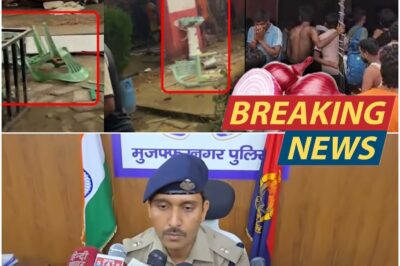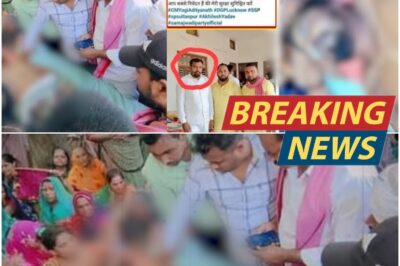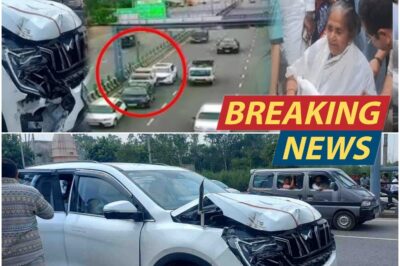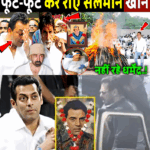Aligarh Mob Lynching: A Community Torn Apart, Political Storms, and Questions of Justice
A Violent Morning in Aligarh
On a humid Saturday morning, the village of Alhadapur, nestled in Uttar Pradesh’s Aligarh district, awoke to a scene that would soon dominate national headlines and ignite fierce political debate. What began as a suspicion over the illegal transport of cattle quickly escalated into mob violence, leaving four men brutally beaten, a vehicle torched, and the entire region gripped by fear and outrage.
.
.
.
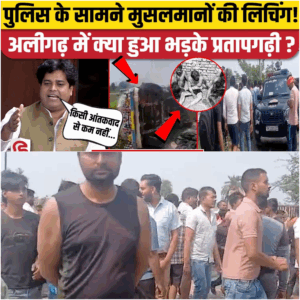
The incident unfolded near the village stadium in the Harduaganj police station area. It was here that a Max pickup truck, suspected of carrying beef, was intercepted by a group of villagers. Fueled by rumors and a frenzy of suspicion, the crowd grew rapidly. What followed was a chilling episode of mob justice: the pickup was vandalized and set alight, and its occupants—four men, including the driver—were mercilessly beaten until they were left half-dead.
Police arrived at the scene only after the violence had spiraled out of control. The battered victims were rushed to the hospital, their survival hanging in the balance. Meanwhile, the charred remains of the vehicle stood as a grim reminder of the chaos that had just unfolded.
The Spark: Suspicion and Social Tensions
The roots of this violence lay in deep-seated suspicions and communal tensions that have long simmered in parts of Uttar Pradesh. Early that morning, word spread that a group of men was transporting beef—an act considered not only illegal but sacrilegious by many in the region. Members of the Akhil Bharatiya Hindu Sena, an organization known for its aggressive stance on cow protection, reportedly chased down the vehicle.
As the pickup was stopped in front of the Alhadapur stadium, the villagers’ anger boiled over. They claimed to have found remains of cattle in the truck, which only fueled their rage. In an instant, law and order gave way to mob rule.
People began to vandalize the vehicle, breaking windows and smashing headlights. Within minutes, someone set the truck ablaze. Amid the chaos, the four men inside were dragged out and beaten with sticks, fists, and whatever else the mob could find. The violence was so extreme that, as bystanders later recounted, it was impossible for any “decent person” to even watch the scene unfold.
Police Response: Too Little, Too Late?
It was only after the violence reached its peak that the police managed to intervene. Officers from several stations, led by SP Dehat Amrit Jain, arrived with reinforcements. They managed to extract the injured men from the mob and transport them to the district hospital. One of the victims was in critical condition and was later referred to JN Medical College for advanced treatment.
Despite the police presence, tensions remained high. Villagers blocked the Delhi-Kanpur highway, using the remains of the cattle and the burnt vehicle to form a roadblock. They demanded immediate action against those allegedly involved in cow slaughter and accused the police of collusion and negligence.
The police, meanwhile, tried to restore order by promising strict action. Heavy police deployment was maintained in the area to prevent further violence. As videos of the incident circulated online—too graphic for broadcast—the entire state watched in horror.
Political Fallout: Imran Pratapgarhi’s Strong Words
The brutality of the incident and its communal overtones quickly turned it into a political flashpoint. Among the first to react was Congress MP Imran Pratapgarhi, who took to social media to condemn the attack and question the Yogi Adityanath government’s law and order record.
In a post on X (formerly Twitter), Pratapgarhi wrote:
“The way meat traders were lynched by a mob in Aligarh yesterday is no less than terrorism. No civilized person can even bear to watch such visuals. First, extortion was demanded from the traders. When that failed, their vehicle was set on fire and they were attacked with the intent to kill. Is this the state of law and order in Uttar Pradesh? While India is sending a message of unity to the world, such visuals are an embarrassment for the government. Does the administration have no control over these goons, or is there a free hand given for lynching of Muslims? Will the administration take such action that it sets a precedent? I will raise this issue forcefully in the upcoming Parliament session.”
Pratapgarhi also shared a copy of the FIR, which named 13 individuals and listed 20-25 unknown persons as accused. He demanded that the police take swift and exemplary action, warning that anything less would only embolden those who take the law into their own hands.
The Police Version: Official Statements and Community Anger
The Aligarh police, under pressure from both the public and political leaders, issued a statement on X:
“Information was received that some people were transporting cattle in their vehicle for slaughter. Some villagers stopped them and assaulted them. Upon receiving the information, senior officers and local police reached the spot immediately. The four people who were beaten were rescued from the scene for their safety and admitted to the hospital for treatment. All allegations are being investigated.”
SP Dehat Amrit Jain further clarified:
“Upon receiving information about the transportation of cattle, some villagers stopped the vehicle and assaulted those inside. The police arrived promptly, rescued the victims, and sent them for medical treatment. The accused are being identified, and samples have been collected for investigation. An FIR has been registered, and action will be taken as per the findings of the ongoing investigation.”
Despite these assurances, anger simmered in the community. Many villagers insisted that the incident was a direct result of police inaction, and some even alleged that certain officers were complicit in the illegal trade. Demands were raised for the suspension of any police personnel found to be involved.
The Aftermath: Divided Narratives
The fallout from the lynching was immediate and profound. The BJP’s youth wing accused the police of acting under pressure and deliberately filing cases against local leaders who had intervened to “save the village from illegal cow slaughter.”
Media interviews with those named in the FIR revealed a sense of betrayal. “If Bholu Bhai, the former village head, had not intervened, I would have died,” said one survivor. “But now, cases are being filed against him and our friends. Was it only us who went there? There were at least 8-10 people with us, and when the police called everyone, cases were filed against all of us under serious charges.”
Local BJP leaders warned that any legal action against those “protecting cows” would not be tolerated, further polarizing the situation.
Meanwhile, the police maintained a heavy presence in Alhadapur, hoping to prevent further unrest. The remains of the cattle were buried by order of the authorities, and the injured were kept under observation in the district hospital.
National Debate: Law, Order, and Communal Tensions
The Aligarh mob lynching quickly became a symbol of the larger issues plaguing Uttar Pradesh and much of India: the rise of vigilantism, the politicization of cow protection, and the vulnerability of minority communities.
Political leaders across the spectrum weighed in, with some condemning the violence and others justifying the actions of the mob as “defense of faith.”
Civil society activists decried the normalization of mob justice. “This is not just about one incident,” said a prominent human rights lawyer. “It’s about the climate of impunity that allows mobs to take the law into their own hands, often with political backing or at least tacit approval.”
As the days passed, more videos and eyewitness accounts emerged, painting a picture of a community torn apart by fear, anger, and mistrust. Some villagers insisted that the men in the truck were innocent traders, while others remained convinced they were involved in illegal activities.
The Victims: Stories of Pain and Survival
In the hospital, the four injured men struggled to recover from their wounds—both physical and psychological. One of them, barely conscious, whispered to a journalist, “We were only trying to earn a living. We never thought we would be attacked like this.”
Their families waited anxiously outside the hospital, unsure of what the future held. “We want justice,” said one relative. “We want those who did this to be punished, regardless of what anyone says about the cattle.”
For the families of the accused, the situation was equally dire. “My brother only went to help because he thought there was a crime happening,” said the sister of one of the villagers named in the FIR. “Now he is being treated like a criminal.”
The Road Ahead: Justice and Healing
As Aligarh returned to a tense calm, the real work of justice and reconciliation remained. The police promised a thorough investigation, with SP Amrit Jain assuring the public that “all facts would be brought to light, and action would be taken against whoever is found guilty, regardless of their background.”
For many, however, the damage was already done. The incident had deepened communal divides, eroded trust in law enforcement, and left a scar on the conscience of the nation.
Imran Pratapgarhi’s vow to raise the issue in Parliament underscored the national significance of the lynching. “If we do not act now,” he warned, “we risk allowing mob violence to become the new normal. That is something no democracy can afford.”
Play video:
Conclusion: A Community at the Crossroads
The Aligarh mob lynching stands as a grim reminder of the dangers of rumor, communal suspicion, and the breakdown of law and order. It challenges both the state government and the nation to confront uncomfortable truths: about the rise of vigilantism, the politicization of justice, and the need for genuine accountability.
As the investigation continues and political leaders trade accusations, the people of Alhadapur—and millions like them across India—wait for answers. They hope for justice, for healing, and for a day when such violence is no longer possible.
Until then, the memory of that violent morning will haunt Aligarh, a stark warning of what happens when fear and anger override the rule of law.
For more in-depth stories and updates on issues that matter, follow N24 Digital.
News
Missing PG Student Monica from Darbhanga CM College Found in Shocking Condition—Police Stunned
Missing Darbhanga CM College Student Monica Found Safe—Reveals She Left Home Willingly to Marry A week-long mystery surrounding the disappearance…
Chaos on the Kanwar Yatra: Devotees Go on Rampage, Vandalize Dhaba from Muzaffarnagar to Roorkee!
Kanwar Yatra Turns Violent: Kanwariyas Vandalize Dhabas from Muzaffarnagar to Roorkee Over Onion in Food A shocking wave of violence…
Uproar After Samajwadi Party Leader Sunil Yadav’s Death: Ex-MLA and Brother-in-Law Named in FIR!
Uproar in Sultanpur After Samajwadi Party Leader Sunil Yadav’s Mysterious Death: Former MLA and Brother-in-Law Named in FIR A wave…
Shocking Viral Video: Teacher Beats Student with Stick in Bihar School—Discipline or Violence?
Bihar School Turns Battleground: Viral Video Shows Teacher Beaten Brutally by Angry Parents—Discipline or Violence? A shocking video has taken…
Forced to Strip at Knifepoint: Obscenity in the Name of Jobs—What’s Happening in Uttar Pradesh?
Job Promise Turns Nightmare: Woman Forced to Undress at Knifepoint in Uttar Pradesh Official’s Quarters Uttar Pradesh: A shocking video…
UP Education Minister Injured in Road Accident as Convoy Cars Collide
UP Education Minister Gulab Devi Injured in Road Accident as Convoy Cars Collide Hapur, Uttar Pradesh: Uttar Pradesh’s Education Minister,…
End of content
No more pages to load


